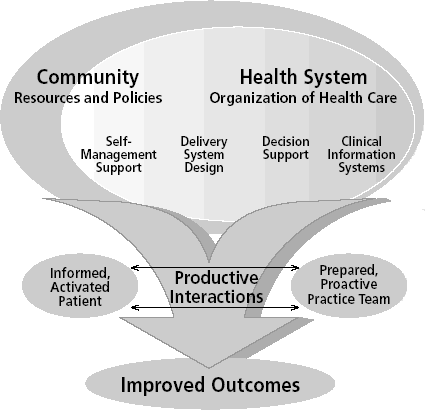 | |
     |
< Previous | Home | Next > Chapter
1
What is a primary care approach to the treatment of HIV/AIDS and why is it important? TOP People with HIV/AIDS can live longer, healthier lives because of advances in treatment of HIV infection. However, longer lives are associated with increased prevalence of 1) adverse effects of HIV infection, 2) adverse effects of the drugs used to treat HIV, and 3) concurrent medical conditions that would occur in the absence of HIV. These long-term complications have put HIV infection in the realm of chronic diseases rather than of infectious diseases, which usually respond to short-term clinical interventions. Effective management of chronic diseases in the primary care setting requires the coordination of interventions that occur at the level of the clinical services, the community supports for those clinical services, and the individual patient. While clinical services begin in the primary care clinic, community supports are needed, and the patient must be engaged to enhance self-management. The coordinated interventions together contribute to the desired clinical outcomes. The Chronic Care Model, which is used in the design and quality improvement activities of clinical services, conceptualizes how these factors impact the clinical outcome of chronic disease management (see Figure 1-1). Figure 1-1. The Chronic Care Model
Source: Adapted from Wagner EH. "Chronic disease management: What will it take to improve care for chronic illness?" Effective Clinical Practice. 1998;1:2-4. Reprinted with permission. The Chronic Care Model was developed by Ed Wagner, MD, MPH, Director of the MacColl Institute for Healthcare Innovation, Group Health Cooperative of Puget Sound, and colleagues with support from The Robert Wood Johnson Foundation. Further details can be found at www.ihi.org. What is the purpose of this guide? TOP This book addresses several important aspects of HIV/AIDS care and treatment in a concise, accessible format; it is not meant to be a comprehensive reference book. Recommended references and citations are provided for the reader to be able to access in-depth information on topics that are particularly important and/or controversial. Appropriate use of antiretroviral drugs, treatment of opportunistic infections, symptom management, treatment of concurrent medical conditions, and other specific interventions to treat HIV disease and its complications are addressed. The format
of this guide is designed to provide practical information for the
common questions that arise in the care of patients with HIV infection.
Recognizing the broader array of best practices that contribute
to effective clinical outcomes among patients with a complex array
of service needs, the authors also address patient evaluation, adherence,
mental health, substance abuse, overall clinic management, and other
factors that lead to improved patient outcomes according to the
Chronic Care Model. Last, because the authors recognize the challenges
of maintaining clinical practices in the face of rapidly changing
and ever more complex treatment interventions, a chapter on sources
for updated and in-depth clinical information is provided. Pediatric
HIV/AIDS treatment is not addressed in this book. Who is the target audience? TOP The target
audience is providers of primary medical care, such as physicians,
physician assistants, and nurse practitioners, who are taking care
of a small but perhaps an increasing number of HIV-infected persons
but who are not experts in HIV care. Parts of this book will also
be useful for nurses, counselors, pharmacists, and others seeking
specific, concise information about the treatment of HIV-infected
persons. Last, specific chapters on clinic management and quality
improvement are relevant for those responsible for the administration
of clinical sites treating patients with HIV/AIDS. Clinicians with
small numbers of patients with HIV/AIDS are encouraged to seek appropriate
expert consultation when complex clinical situations arise. Provider
expertise in HIV care is essential in many treatment decisions.
In fact, patient outcome is correlated with the number of patients
with HIV a provider has treated. For more information, see Suggested
Resources in Chapter 18 on Keeping Up-to-Date: Sources of Information
for the Practicing Clinician. What is the purpose of the pocket guide? TOP The guide is a pocket-sized quick reference that provides a summary of all Federal guidelines dealing with HIV, including antiretroviral therapy (ART), prevention of opportunistic infections (OIs), management of class adverse reactions, treatment of tuberculosis (TB) and hepatitis C (HCV), laboratory testing, prevention after occupational exposure, and HIV management in pregnancy. It is presented in a format that is intended for point-of-care decision making: it can be carried in the clinic and at the bedside to rapidly access needed information for patient treatment. The pocket guide will be updated more frequently than the book to meet rapid changes in HIV medication options and recommendations. How will the guide keep pace with the rapidly changing field of HIV/AIDS treatment? TOP The book details principles and major recommendations for the treatment of persons with HIV/AIDS that will remain, for the most part, relevant for the coming 2 or 3 years. However, the field of HIV treatment is very fluid, and specific drugs and drug combinations evolve rapidly. For this reason, such information has been consolidated in the pocket guide, which will be revised, with updates available in the on-line version on the HIV/AIDS Bureau (HAB) website. Revisions of the pocket guide will include new drugs, new treatment guidelines, and new side effects as well as new drug interactions. In addition to the pocket guide, information on other useful websites is provided to help with keeping up-to-date.
|
|||||||
![]()
Top
| Home | HRSA
| HHS |
Disclaimer | Accessibility
| Privacy | Download
Adobe Reader| | Freedom of Information
Act
